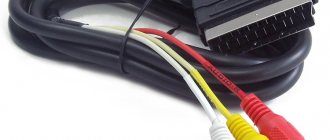Content:
- 1 Common causes of streaks
- 2 Possible types of stripes and breakdowns 2.1 Thin horizontal stripe
- 2.2 Multi-colored horizontal
- 2.3 Dark, black horizontal and vertical stripes
- 2.4 Small vertical defects
- 2.5 Pink vertical strokes
- 2.6 Vertical white line
- 2.7 Blue vertical lines
- 2.8 Green vertical defects
- 2.9 Red or yellow vertical stripe
- 3.1 Problems with TV settings
- 4.1 Other display failures
Constant use, long periods of continuous viewing, improper maintenance of technicians - all can cause streaks to appear on the TV screen. Even the most modern models are not immune to this malfunction. Moreover, the stripes themselves can have a different character: appear temporarily, be horizontal, vertical, white, black, colored. In each case the reasons are different. After diagnosis, some breakdowns can be repaired yourself. But if the matrix fails or another complex breakdown occurs, it is better to contact the specialists so that you do not have to buy new household appliances.
Lines appeared on the TV. Their types and causes
In modern plasma, Led, LCD TVs, this problem is a common occurrence. It leads to deterioration in the quality of the transmitted image, as a result of which the perception of television programs is not possible. At the initial stage of the appearance of stripes on the TV screen, make sure that the cable providing the image is properly connected.
It is worth checking whether the connector is clogged with dirt or dust. There is also a possibility that the settings on the TV itself have gone wrong; you can check this using automatic image adjustment. If these actions did not help correct this defect, then this indicates the emergence of a more serious problem.
Horizontal or vertical stripes on the device as a result of critical malfunctions may appear with some periodicity, or always consistently, accompanied by ripples, image distortion, flickering or stopping “stuck” frames.
Let's look at the circumstances under which stripes may appear on a TV:
- Faulty matrix cable contact;
- Damage to the matrix itself;
- Failed elements of microcircuits and boards.
Absolutely all equipment does not have a guarantee against various breakdowns, but basically these problems can be repaired. The problem is the price of certain spare parts, which can cost the same or exceed the cost of new ones - in this case it is recommended to refuse repairs. Since replacing circuits and parts will not guarantee the serviceability and correct operation of the TV in its further operation.
Common Causes of Streaks
The ability to watch TV programs is achieved by broadcasting an encrypted signal, decoding it by hardware and displaying the picture using a matrix. Common reasons why horizontal stripes appear on a TV while watching movies are:
- Dirt gets into the video signal cables. Very small debris, dust, and moisture may get in.
- Incorrect image settings, broken default settings.
You can fix these errors on your own. But the reasons for the appearance of a large number of vertical stripes can be much more serious:
- The matrix has failed;
- The matrix cable is broken and oxidized;
- Malfunctions in software modules.
Advice. You shouldn’t figure out the faults of expensive modern Smart TVs on your own. Maximum – you can check the image settings. It is better to entrust the elimination of other breakdowns to the specialists.
Let's take a closer look at what stripes of color, type and quantity indicate what errors in the operation of televisions.
Possible types of stripes and breakdowns
Horizontal and vertical stripes on the TV screen occur due to software glitches, internal and external breakdowns. It is worth paying attention to the color and the number of defects in order to understand what the error may be.
Thin horizontal stripe
It is worth paying attention to the frame scan, which gets lost after sudden voltage surges, for example, during a thunderstorm or power outage. As a result of the same problems, microcracks may appear on microcircuits.
Multi-colored horizontal
Such stripes can fill either part of the screen or the entire monitor. They have different shades and resemble ripples. Such a malfunction often indicates a failure of the matrix cable. In this case, it needs to be re-soldered, but you should entrust this process to a professional. He will immediately determine whether there are any faults in the matrix or image control unit.
Dark, black horizontal and vertical stripes
They can be located in the center or throughout the monitor. Such stripes on the TV screen often indicate serious and costly breakdowns. These include damage to the decoder, without which it is impossible to reproduce the signal. Most often it requires a complete replacement.
Advice. If black horizontal stripes appear on the TV screen, you should not delay repairs, even if at first they do not interfere with viewing much. The more violations, the more expensive the repairs will be.
Small vertical defects
Depending on the type of TV, such breakdowns indicate failure of the decoder or matrix column. The reasons are power surges. If even one stripe is not eliminated in time, it will spread until it covers the entire screen.
Pink vertical strokes
The monitor matrix gives similar failures. They can appear not only from power surges in the network, but also from mechanical damage to the TV.
Normal wear and tear can also cause pink vertical streaks to appear on your TV screen. A purple defect is also preparing about him.
Important! Don't look for reasons why your new TV is broken. The appearance of stripes on the screen is a manufacturing defect that must be corrected under warranty. To do this, just contact the store where you purchased the equipment or a service center from the manufacturer.
Vertical white line
The strip can be small, barely noticeable, or, conversely, thick and pronounced. The reason is the matrix failure or problems in its operation. Checking whether this TV element is really damaged is quite simple:
- Gently press your finger onto the white line;
- See if she has disappeared or not;
- If it disappeared and then reappeared, there is a breakdown in the matrix.
But do not press too hard, otherwise you can damage the equipment even more.
Blue vertical lines
After overheating or prolonged use, blue vertical stripes may appear on the TV screen. They indicate problems with the video card, which has its own expiration date. Another reason is the peeling of the matrix cable or the peeling of the solder ball of the video processor of the BGA substrate.
Advice. Even if the cause is identified, you should not disassemble the TV yourself unless you are a master. The elements of the matrix and microcircuits are so small and fragile that it is not difficult to damage them.
Green vertical defects
Such breakdowns indicate damage to the cable connecting the image forming board and the LCD matrix. Such a line can be anything: from a wide line of several centimeters to a narrow line of 1-3 pixels.
Interesting fact. If the strip appears suddenly after the TV has been running for a long time, turn off the equipment and let it cool. Often, along with overheating, the defect also goes away.
Red or yellow vertical stripe
Failure of the matrix daisy chain connection often produces red stripes. They also indicate that the cable connectors are damaged or dusty. It is not uncommon for a track on the board to peel off or the VGA cable to become damaged. Some of these defects can be repaired at home.
Vertical yellow lines are a sign of problems with the video card. And also after moisture gets on the TV, as a result of which the contacts swell and oxidize.
Important! Despite the availability of a large number of instructions on how to independently solder cables or repair microcircuits, you should not do this without special education. The exception is that you already want to buy new equipment, but left this one for personal experiments.
The main reasons causing a white stripe to appear on the screen
- Failure of the frame scanning cascade microcircuit;
- Problems with piping capacitors (ensuring operating modes) of the vertical scan microcircuit;
- Malfunctions in the power supply system of the microcircuit of the vertical scanning output stages;
- Problems with reliable contact of frame scanning elements (ring cracks).
By assessing the width of the horizontal stripe that appears on the TV screen (it can be very narrow or reach 3-4 centimeters), you can make a preliminary decision about which element or block of the TV caused the malfunction.
Step one. As is usually customary when repairing complex electronic equipment, troubleshooting should begin with the simplest and most obvious. In this case, you should carefully examine, using a magnifying glass (loupe), the soldering areas of the frame microcircuit and its wiring elements for the presence of ring cracks.
This seems surprising, but for some television brands, for example, the Kaliningrad company Erisson, ring cracks at the soldering points of circuit elements may appear already in the first year of operation of the device. For other manufacturers, this time can last for many years. In any case, such a malfunction can be eliminated by carefully soldering the problematic contacts.
Step two . The next step in finding the cause of the malfunction will be to check the supply voltage on the frame chip. Depending on the type of chip used, it may be supplied with one or two voltages, say 9 and 45 volts. In this case, the input circuits of the microcircuit are powered at a low voltage level, and the output stage is powered at a higher voltage level. Most often, power to the frame chip is supplied from the TDKS combined transformer unit (diode-cascade line transformer), but sometimes you come across models in which the voltage is supplied directly from the TV’s power supply.
It should be noted that power is supplied to the corresponding pins of the frame microcircuit through protective (breaking) resistors. When these resistors fail, a horizontal stripe appears on the TV screen, so we can conclude that the frame chip has failed or is operating in overload mode.
Step three. If the break resistors are alive and well, then you should look for the cause of the problem in the electrolytic capacitors of the microcircuit. Failure of electrolytes can be determined by their appearance: they are usually swollen and deformed. Most often, the capacitors of the power supply circuit of the frame microcircuit and the electrolytes of its output stage fail. Typically these are high-capacity capacitors - approximately 1000-2000 µF.
If it cannot be determined from its appearance that the capacitor is faulty, then the fault can be eliminated by simply replacing the suspicious element with a guaranteed working one.
Step four. The malfunction of the frame microcircuit itself can be determined by cracks and chips on its body, as well as by unusually strong heating during operation.
Without a doubt, other reasons can cause the appearance of a horizontal stripe on the TV screen, for example, a break in the wires of the frame deflection coils, but this happens extremely rarely.
What problems can be fixed at home?
White or colored stripes do not appear on the TV screen due to a poor signal from the operator. Therefore, you should not call the line and ask about serviceability. But from dirt getting into the connector for connecting the antenna or cable - quite well. These microparticles do not completely block the signal, but only spoil it.
Before cleaning the connector, you can check whether it is the correct one. To do this, plug the flash drive into the TV or connect the screen to the computer via another wire. If the malfunctions go away, you can clean or replace the connector. For this:
- Carefully inspect the connector on the TV. Make sure there are no mechanical creases or damaged contacts. Take a soft brush and wipe off any dust.
- Look at the wire connector. Also visually check for damage and clean with a soft brush.
- Be sure to review the entire cable. Avoid kinks, removed protective braiding, or furniture on the wire.
Important! If you need to replace a connector or wire from a digital television operator, you need to call a specialist. They know exactly which cable was used. And the cost of such repairs is low.
Problems with TV settings
Not fair, but image settings can affect the appearance of stripes. To eliminate this error, you need to take the TV remote control. Go to settings. Set the default parameters. The exact instructions depend on the brand and series of TV. You can read the instructions and find the factory parameters on the official websites of the manufacturer.
Important! Do not confuse ripples and stripes on the screen. When the picture blinks, the image jumps - it's ripples. Constant even stripes with different thicknesses mean possible failures in the settings, failure of the internal components of the TV.
Possible causes of malfunction
According to statistics, every third TV malfunction is associated with horizontal stripes on the device screen.
Among the probable causes of failure are:
- partial failure of the frame scanning chip;
- faulty capacitors;
- contamination of the contacts of the TV power supply;
- damage to matrix cable contacts;
- burnt resistors.
Owners of both plasma and LCD TVs may encounter each of these problems. To identify the exact cause of the malfunction, you will need to diagnose the TV device.
Breakdowns requiring repair in service centers
If the stripes on the TV screen are not associated with wires and settings, the reason is a breakdown of the internal elements. Only a specialist can carry out an accurate diagnosis. It takes into account the type of matrix, carries out diagnostics, and corrects errors.
There is no need to carry out repairs yourself for a number of reasons:
- Even when disassembling the TV, you can damage various components. Especially in thin models, where all the elements are located very close to each other.
- If you manage to get to the matrix, when dismantling it, it is easy to damage the cable, increasing the cost of repairs.
- The matrix must be soldered under a microscope using a special set of tools. There are no such things in a regular “home workshop”.
Important! Do not under any circumstances attempt to disassemble the TV while it is under warranty. Even if you unscrew two screws before contacting the service center, your case may be considered out of warranty due to attempts at self-repair.
Other display failures
Do not confuse stripes that appeared due to internal violations, failures and mechanical damage. If the monitor is broken as a result of an object hitting it or falling, there will be not only stripes, but also spots, separate light and dark areas.
Dust getting under the protective panel causes dark, white areas to appear. And these are also not stripes, which most often indicate a breakdown of the matrix and the elements connecting to it.
In any situation, it is worth calling a specialist for diagnostics. And if the amount of repairs seems too large, there is always the option of buying new TVs at an affordable price and simply replacing home appliances.
Faulty contacts
Another reason for the appearance of stripes on the SAMSUNG TV screen is poor contact between the connections. Most often, this problem occurs due to poor quality assembly of the TV at the factory. Also, a poor connection between the contacts can be caused by moisture getting into the TV body during unsuccessful cleaning of the screen with a damp cloth or napkin.
To check the contacts, a visual inspection of the board is sufficient. In some cases, a magnifying glass or other magnifying device can help. Poor contact may occur due to oxidation. It is easy to identify: a green coating will appear on the board. You can remove this plaque with a blade or knife.
After this, you need to check the voltage between the contacts or “ring” them. To do this, use a special device - a multimeter.
If green deposits have covered more than 60% of the contacts on the board, then regular cleaning with a sharp object may not give a positive result. Here it is better to contact a service center, because there is a possibility that you will need to completely replace the board or matrix cable (depending on the area where the largest accumulation of green plaque is located).
Recommendations for caring for equipment to prevent streaks from appearing on the screen
To prevent a vertical stripe or horizontal colored stripes from appearing on a plasma or LCD TV, you should properly care for the equipment. To extend the service life, follow these tips:
- Do not wash equipment with water or a wet cloth. Any ingress of moisture causes a short circuit, as well as burnout and oxidation of internal elements. As a result, not only streaks may appear, but the TV may also completely fail.
- Constant, daily movement of the TV causes internal damage. Microcracks appear and cables may become disconnected. Therefore, it is important that the device is fixed in one place and not subject to constant movement.
- Do not allow dust to accumulate on the display or the back panel of the TV. Microparticles gradually penetrate inside and stick to the contacts. As a result, the components overheat, the contacts become deformed and stripes appear on the screen. The best option for getting rid of dust is to blow it with a vacuum cleaner, but taking all precautions.
Important! Any cleaning, moving, or fixing of the TV can only be done when it is turned off. And not just turned off by a button, but pulled out of the network. After wiping and treating to remove dust, you should not immediately turn on the equipment. You need to wait 2-5 minutes.
Stripes on the screen - what to do?
A well-made TV serves its owner for a long time, bringing him positive emotions. On a television screen, any program, be it Formula 1 or the misadventures of another Isaura, looks brighter compared to a computer monitor. Distress occurs when the matrix fails or with the appearance of certain image defects.
In this case, manufacturers thus resort to a very primitive solution. Allows you to set the color of these unused bars, such as grey. In this way, both the transmitting and side broadcasting points operate, and relatively uniform wear occurs.
There are matrix cables with SMD components installed on them. And there are times when these components become unsoldered and fall off. In this case, you need to find out which components were installed and restore their presence on the cable. You can find out from the diagram or by contacting specialists
Finally, we note the most important thing - the panel must be “burned”. It is initially susceptible to shooting much more than later. Some companies boast that they are burned in the plant so the customer doesn't have to deal with it. If not, a few simple rules apply to your new 200 hour runner.
The most common defects include the appearance of stripes on the screen and dead pixels. There are quite a few reasons for screen streaking. Let's take a closer look at them.
General recommendations
What to do if stripes appear on your TV? Do not panic, but carry out diagnostics.
- Carefully examine the strips themselves. Determine their color, quantity, location.
- Try to let the TV cool down. Disconnect it from the network. Leave for 30-60 minutes. Ventilate the room. Turn it on and check if the problems go away.
- Inspect the cable through which the signal is supplied to the TV. Clean the connectors with a soft brush and make sure they are inserted correctly.
- Go to the TV settings. Set the image parameters to factory settings.
And if all else fails, it’s best to call a technician or take the equipment to a service center. So, the repair will be faster and cheaper than trying to solder the matrix yourself or replace the cable.
Found a mistake? Select it and press ctrl+enter
- 60











